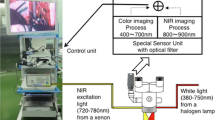Abstract
Background
Fluorescent technology has recently become a valuable tool in the surgical management of neoplastic and vascular lesions. The availability of microscope-integrated fluorescent modules has facilitated incorporation of this technology within the microsurgical workflow. The currently available microscope integrated modules use 5-aminolevulinic acid (5-ALA) and indocyanine green (ICG) as fluorophores.
Methods
Fluorescein sodium is a fluorescent molecule that has been used specifically in ophthalmology for the treatment of retinal angiography. A new microscope-integrated fluorescent module has been recently developed for fluorescein. We employed this technology to maximize resection of tumors and perform intraoperative angiography to guide microsurgical management of aneurysms and arteriovenous malformations.
Results
Fluorescein fluorescence allows the surgeon to appreciate fluorescent structures through the oculars while visualizing non-fluorescent tissues in near natural colors. Therefore, the operator can proceed with microsurgery under the fluorescent mode. We present three representative cases in which the use of fluorescein fluorescence was found useful in the surgeon’s decision making during surgery.
Conclusions
The applications of this new microscope-integrated fluorescent module are multiple, and include vascular and oncologic neurosurgery. Further clinical investigations with large patient cohorts are needed to fully establish the role of this new technology.



Similar content being viewed by others
References
Dashti R, Laakso A, Niemelä M, Porras M, Hernesniemi J (2009) Microscope-integrated near-infrared indocyanine green videoangiography during surgery of intracranial aneurysms: the Helsinki experience. Surg Neurol 71:543–550, discussion 550
Dilek O, Ihsan A, Tulay H (2011) Anaphylactic reaction after fluorescein sodium administration during intracranial surgery. J Clin Neurosci 18:430–431
Feindel W, Yamamoto YL, Hodge CP (1971) Red cerebral veins and the cerebral steal syndrome. Evidence from fluorescein angiography and microregional blood flow by radioisotopes during excision of an angioma. J Neurosurg 35:167–179
Karhunen U, Raitta C, Kala R (1986) Adverse reactions to fluorescein angiography. Acta Ophthalmol (Copenh) 64:282–286
Keerl R, Weber RK, Draf W, Wienke A, Schaefer SD (2004) Use of sodium fluorescein solution for detection of cerebrospinal fluid fistulas: an analysis of 420 administrations and reported complications in Europe and the United States. Laryngoscope 114:266–272
Koc K, Anik I, Cabuk B, Ceylan S (2008) Fluorescein sodium-guided surgery in glioblastoma multiforme: a prospective evaluation. Br J Neurosurg 22:99–103
Kwan ASL, Barry C, McAllister IL, Constable I (2006) Fluorescein angiography and adverse drug reactions revisited: the Lions Eye experience. Clin Experiment Ophthalmol 34:33–38
Kwiterovich KA, Maguire MG, Murphy RP, Schachat AP, Bressler NM, Bressler SB, Fine SL (1991) Frequency of adverse systemic reactions after fluorescein angiography. Results of a prospective study. Ophthalmology 98:1139–1142
Little JR, Yamamoto YL, Feindel W, Meyer E, Hodge CP (1979) Superficial temporal artery to middle cerebral artery anastomosis. Intraoperative evaluation by fluorescein angiography and xenon-133 clearance. J Neurosurg 50:560–569
Moore GE, Peyton WT (1948) The clinical use of fluorescein in neurosurgery; the localization of brain tumors. J Neurosurg 5:392–398
Moosbrugger KA, Sheidow TG (2008) Evaluation of the side effects and image quality during fluorescein angiography comparing 2 mL and 5 mL sodium fluorescein. Can J Ophthalmol 43:571–575
Murray KJ (1982) Improved surgical resection of human brain tumors: Part I. A preliminary study. Surg Neurol 17:316–319
Okuda T, Kataoka K, Yabuuchi T, Yugami H, Kato A (2010) Fluorescence-guided surgery of metastatic brain tumors using fluorescein sodium. J Clin Neurosci 17:118–121
Pacurariu RI (1982) Low incidence of side effects following intravenous fluorescein angiography. Ann Ophthalmol 14:32–36
Placantonakis DG, Tabaee A, Anand VK, Hiltzik D, Schwartz TH (2007) Safety of low-dose intrathecal fluorescein in endoscopic cranial base surgery. Neurosurgery 61:161–165, discussion 165–166
Raabe A, Nakaji P, Beck J, Kim LJ, Hsu FPK, Kamerman JD, Seifert V, Spetzler RF (2005) Prospective evaluation of surgical microscope-integrated intraoperative near-infrared indocyanine green videoangiography during aneurysm surgery. J Neurosurg 103:982–989
Shinoda J, Yano H, Yoshimura S-I, Okumura A, Kaku Y, Iwama T, Sakai N (2003) Fluorescence-guided resection of glioblastoma multiforme by using high-dose fluorescein sodium. Technical note. J Neurosurg 99:597–603
Stummer W, Novotny A, Stepp H, Goetz C, Bise K, Reulen HJ (2000) Fluorescence-guided resection of glioblastoma multiforme by using 5-aminolevulinic acid-induced porphyrins: a prospective study in 52 consecutive patients. J Neurosurg 93:1003–1013
Stummer W, Stepp H, Möller G, Ehrhardt A, Leonhard M, Reulen HJ (1998) Technical principles for protoporphyrin-IX-fluorescence guided microsurgical resection of malignant glioma tissue. Acta Neurochir (Wein) 140:995–1000
Stummer W, Pichlmeier U, Meinel T, Wiestler OD, Zanella F, Reulen HJ, ALA-Glioma Study Group (2006) Fluorescence-guided surgery with 5-aminolevulinic acid for resection of malignant glioma: a randomised controlled multicentre phase III trial. Lancet Oncol 7:392–401
Tanahashi S, Lida H, Dohi S (2006) An anaphylactoid reaction after administration of fluorescein sodium during neurosurgery. Anesth Analg 103:503
Uzuka T, Takahashi H, Fuji Y (2007) Surgical strategy for malignant glioma resection with intraoperative use of fluorescein Na. No Shinkei Geka 35:557–562
Wrobel CJ, Meltzer H, Lamond R, Alksne JF (1994) Intraoperative assessment of aneurysm clip placement by intravenous fluorescein angiography. Neurosurgery 35:970–973, discussion 973
Yannuzzi LA, Rohrer KT, Tindel LJ, Sobel RS, Costanza MA, Shields W, Zang E (1986) Fluorescein angiography complication survey. Ophthalmology 93:611–617
Acknowledgments
The authors thank Dr. Roland Guckler for his assistance with technical information in this article.
Conflicts of interest
None.
Author information
Authors and Affiliations
Corresponding author
Rights and permissions
About this article
Cite this article
Rey-Dios, R., Cohen-Gadol, A.A. Technical principles and neurosurgical applications of fluorescein fluorescence using a microscope-integrated fluorescence module. Acta Neurochir 155, 701–706 (2013). https://doi.org/10.1007/s00701-013-1635-y
Received:
Accepted:
Published:
Issue Date:
DOI: https://doi.org/10.1007/s00701-013-1635-y




